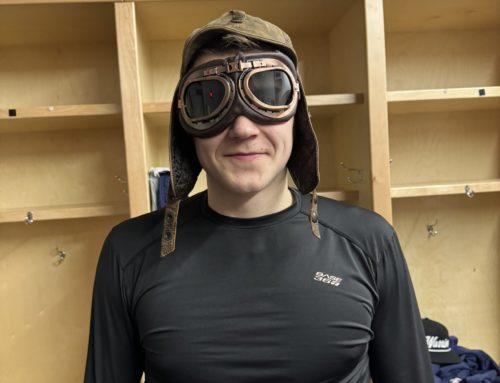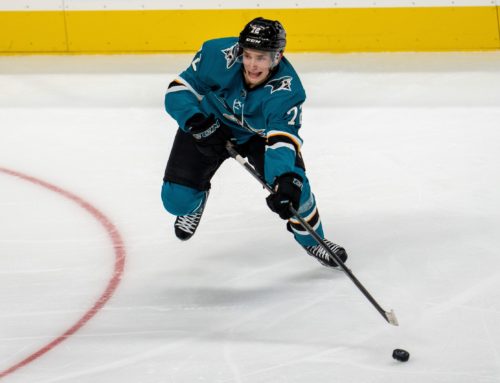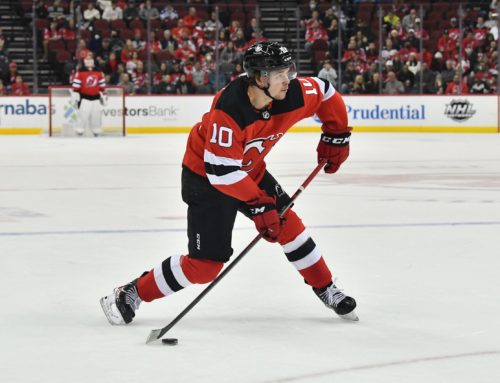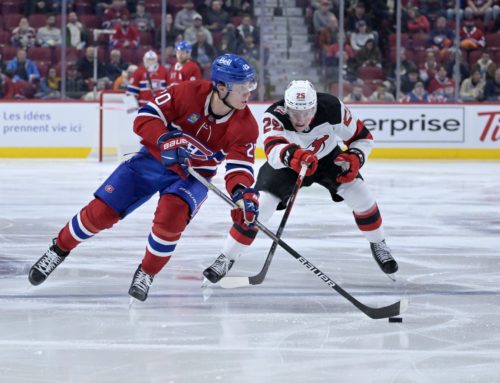The Century Mark: Podkolzin, Liljegren, Jarvis
Alex Wyatt
2022-12-21
Image credit: Mike Ehrmann, CanesCountry.com
Every month, Alex Wyatt digs into some players who have reached the 100 NHL games played threshold, as this is the mark, or near it, that many leagues use as their threshold for players casting off their minors eligibility.
I am back for another season of the Century Mark and look forward to diving into a few players each month who are nearing or just crossing the 100 NHL games played mark. Why 100 games? Other than making the title of the column more catchy, this is a common threshold for farm eligibility in dynasty and deep keeper leagues. After passing the century mark, prospects must be either brought up to the main squad or let go. Because they now take up a keeper slot on the Pro Roster at the end of the year, they need to be pulling their weight, or close to it, to earn their spot.
Even if your league uses a shallower cut off, 100 games is also halfway to the Breakout Threshold for regular-sized players and a quarter of the way for exceptional-sized players. What follows should give you plenty of food for thought about these players’ current deployment and utilization, as well as a refresher on their pedigree. As always, I will do my best to provide context to the charts and tools I reference.
Now that we are all caught up, let’s get into it.
Vasili Podkolzin (21, RW, VAN)
Taken just inside the top ten of the 2019 draft, much was made of Podkolzin’s penchant for barging his way through opposing defensemen, which paired brilliantly with his strong skating and ability to protect and carry the puck. After being drafted, he spent a few seasons at various levels of pro hockey in Russia getting in some seasoning and representing his home country in several international tournaments. His progression was positive, and the stage was set for him to cross over to North America and debut with the big club in 2021-22.
He gave Canucks fans plenty to be excited about in his rookie season, scoring a goal in his second game in the big leagues and adding three more before he played his tenth game. His scoring was fairly consistent as well across his first season:
His goals, assists, and ice time (TOI) were fairly consistent over the first three quarters. When he was given a longer leash near the end of the season, he effectively doubled his point production and seemed to be finding his stride. That TOI lift and the resulting bump in production came during a period where he also played with better linemates, seeing regular shifts alongside Brock Boeser and Elias Pettersson as well as JT Miller and Connor Garland. Previously he had played with middle sixers Alex Chiasson, Nic Petan, Nils Hoglander et al.
His 2021-22 shooting percentage was a reasonable 12.2%, though it was a touch higher than his 7.5% career KHL average. He also got just a shade under 13 minutes a night for the season and put up a shot and a half plus a hit per game. He supplied 14 goals and 12 assists as a rookie over his first 79 NHL games. Very respectable numbers for a youngster breaking into the main stage.
So what does the new season show us about Podkolzin as he nears the Century Mark?
His 2022-23 is still just over a “quarter” old as of time of writing, and the sophomore jinx, which catches more than it spares, appears to have hit Podkolzin.
*Author’s note: He saw some time as a healthy scratch right around the time I began writing about him, and was ultimately sent down to Abbotsford of the AHL. He currently has five points in nine games for the Baby Canucks, and is putting up two shots per game.*
A few things are the same for Podkolzin this year: his opportunity and time on ice haven’t changed; he is skating nearly the same minutes (12.5 average) as last year, shooting slightly less (one shot per game) and hitting slightly more (1.3 hits). His linemates aren’t much different either, as he has seen time with Elias Pettersson, red-hot new addition, Andrei Kuzmenko, Connor Garland, and the white-hot Bo Horvat. So why do we see him pacing for 15 points per 82, instead of the 27 point pace he had as a rookie?
Luck appears to play a huge part of it, and the type of deployment does as well.
For starters, Podkolzin is shooting 0% across 18 shots on goal, which is a nasty streak but one that will regress positively soon enough. Were he shooting at last year’s shot percentage, he’d have two more goals than he does now, which would give him essentially 10 in an 82 game season. He’s also being given 5% of the available Power Play minutes this season vs 13.5% of the minutes available last season.
Compare that to Kuzmenko who, despite being in his first NHL season, is five years older than Podkolzin and is getting 55% of the available Power Play ice time. Podkolzin’s utilization explains a decent amount of his decline in production in year two, especially when combined with his frustratingly bad luck in shooting percentage. His even-strength IPP—which stands for Individual Points Percentage and tracks what percentage of the goals scored while he was on the ice he registered a point on, giving an indication of how much involvement a player has in offensive outcomes, and how much the play flows through them—is 50% this year vs 56.5% last year. Not a big difference. His offensive zone start percentage (OZ%), Corsi For (CF), and Expected Goals (xG) this year are all nearly identical to 2021-22 as well.
The more I look at Podkolzin’s underlying numbers this season and compare them to last, the more I see a buy-low opportunity for him. The question would be, what type of ceiling could we be rewarded with if we acquire him and need to hold him on our pro roster once he passes 100 NHL games played?
Checking out his card on Hockey Prospecting—by the way, if you aren’t following HP creator Byron Bader on Twitter, I suggest it—you can see that Podkolzin never really compared to high-octane offensive producers from his draft year. The Russian leagues, especially the VHL and MHL, are very difficult to compare with, and many youngsters can see themselves stapled to the bench for all but two and a half minutes a game at times.
Podkolzin never really looked like a star player in the model, which is a player who averages 0.7 points per game for their career, or just about 56 points for a full season. This doesn’t imply that Podkolzin couldn’t break or come near that mark; it just suggests that it is unlikely. What is promising is the massive jump his NHLer probability took between his Draft+2 and Draft+3 years, which implies he has a great likelihood to play over 200 games in his career. Given that he is essentially already halfway there and carried himself well in the first season, I think that’s a safe gamble.
In fairness, I haven’t always kept a close eye on Podkolzin in my travels as a fantasy hockey manager, but in digging into him here for the column, I would reiterate that he appears to be a good buy low candidate in deeper leagues. His underlying numbers have not fallen off from last year’s performance, and the ones that are different are likely to regress positively. He is halfway to his Breakout Threshold, and managers who do hold him have the roster crunch consideration when he loses farm eligibility. I would not sell the farm for him, given that his offensive upside doesn’t appear to be astronomical, but if he can play a heavy game and provide a bit of category coverage with shots and hits, he could be a low-cost keeper for your squad if your rosters are deep enough. Go poke around and see what the acquisition cost would be.
Timothy Liljegren (23, D, TOR)
Part of the fun and agony of fantasy sports is being stuck in a position like we find ourselves in right now with Timothy Liljegren where we have to go with our gut and decide if we can dedicate a pro roster and/or keeper slot to him. In a shallow enough league, you would likely not need a single chart to make that decision, and in a deep enough league, you might be rostering a handful of players who would be lucky to achieve what Liljegren has thus far. Deciding who to release, trade, or stick with is where long-term success can be gained in fantasy hockey. We won’t always get it right but can do our best to think out each decision.
When Liljegren was drafted 17th overall in 2017, the ticket on him was his skating ability and shiftiness in transition. Never touted as a big shooter or goalscorer, but with a decent enough knack of moving the puck, Leafs fans were hoping that they had found another Morgan Rielly, who was earning his keep for the Buds around the same time. Since then, he has had limited playing time, and his long-term future in the Maple Leafs’ defence corps seems no easier to predict than it was back then.
Much discussion surrounds Liljegren these days, mainly on whether he and his regular blueline partner, Rasmus Sandin, are ready to take on more responsibility with the Maple Leafs. Sandin, who was taken one year later in the 2018 draft, has been seen as the more offensive stalwart, though both share an identical 0.32 points per game scoring rate at the time of writing.
With the Leafs’ injuries on the back end—Jake Muzzin out indefinitely with a cervical spine injury, Morgan Rielly shelved for several weeks with a knee injury, and TJ Brodie and Jordie Benn also out of the line up—the opportunity for Liljegren to showcase his game with bigger minutes and bigger responsibility is nigh.
So, does Liljegren look poised to seize the opportunity and start carving out his niche in the Leafs’ top 4?
It has been a quiet season for Liljegren on the offensive front, with his 22-game performance this year showing him underperforming last year’s 61 game effort on a number of fronts. His 19-point pace for 82 games is 12 off of last year’s (31), his shots per 60 are off last year’s pace by a shot and a half (3.2 vs 4.7), hits are slightly higher, and he’s added about half a block per game to his repertoire.
His advanced offensive numbers give us some more insight toward his year thus far, and let’s also reiterate we’re only talking about a 22-game sample size (at the time of writing), but the downward trend offensively continues.
Liljegren’s “luck measurement” or PDO is much higher this year, suggesting the on-ice shooting percentage plus the on-ice save percentage the Leafs’ enjoy with Liljegren on the ice seems due to regress negatively to the mean. He is seeing a decrease in his offensive zone starts, is shooting less per 60 minutes of ice time, and seeing less power play time than he saw last year, even with the injuries to the Leaf’s D-corps.
His IPP on the power play or at even is lower than last year, showing he’s factoring in on the scoring less in 2022-23.
Liljegren is seeing sheltered minutes against relatively weak competition and is performing better than only Justin Holl and the infrequently used Victor Mete when measured by Corsi For. The chart above also shows which young blueliner is getting the most offensive deployment as well: Mr. Sandin.
Lilegren’s projections from near his draft year up until 2020 show a low probability of stardom, which in terms of defensemen on Hockey Prospecting is a career 0.45 point per game average, or 37 point pace across 82 games. The tool also seems lukewarm on his likelihood of suiting up for 200 NHL games, but I would be a bit more optimistic than the 45% the tool suggests.
If you have managed to make it through what must feel like a strip-tearing of Liljegren here, you are likely thinking I have a personal vendetta against the young man. I add to all the numbers I have shared above that defensemen are notoriously long to develop, and Liljegren is a subject of this column because he is nearing 100 NHL games played. His opportunity stands to grow, leading to more opportunities and experience, both with injuries to some key players in the short term, the age of the blue line, and the salary cap crunch in Toronto.
For me however, there are better fantasy options out there for my league depth and scoring settings, and I do not feel I would be able to justify keeping Liljegren over some of those players. I think he has the tools to be a serviceable defenceman in Toronto, but if he was a member of the farm team on my fantasy squad and was losing eligibility soon, unless my league was quite deep or I was short on defensive options, I would likely be moving on from Liljegren. At this point in the season, however, you can afford to wait and see how the rest of the year goes. In the meantime, you are bound to have a manager in your league with Blue-and-White-tinted glasses you could strike up a conversation with.
Seth Jarvis (20, C/RW, CAR)
Certainly one of the most pleasant surprises of the previous season was the emergence of Jarvis—unless of course you cheer for the team I cheer for and you recall he was the price for said team to rid themselves of a contract you just knew was going to cost them a young fella like Jarvis. He is certainly a higher-profile prospect than the previous two, and he is playing fairly similarly as last year based on the underlying metrics, but this season it just feels as if the hype has moderated slightly. In my leagues, he has moved a few times, and generally is not discussed in the chats at all, whereas he was a conversation topic from time to time previously.
So, what gives, as he is due to suit up for his 100th NHL game shortly?
He burst onto the scene with Carolina from the jump, capitalizing on the prime deployment he was given from day one. Jarvis saw himself share the ice at 5 on 5 with Sebastian Aho for more than 40% of the time, take shifts with Andrei Svechnikov, and feature on the Hurricane’s second powerplay, raking in 31% of the team’s available power play minutes. Those are no small feats when you see who plays on PP1 in Carolina.
This season he finds himself ever so slightly falling short of the success that seemed to come easily last year. He is still playing over a third of his even strength minutes with Aho, and the trifecta of those two with Teuvo Teravainen drive play well with a 55.7% share of the shots and a +3 goal differential.
His underlying numbers look great this season, even better than last. He has increased his shooting rate from 7.0 shots per 60 minutes to 7.6. His share of the available power play minutes has increased from 31% to 38.5%. His Corsi For is up 3%. He’s getting two and half more minutes a game, and almost an extra minute per game of power play time. All of these things scream that he should be maintaining production, or even increasing it.
His first 22 games this year, he managed nine points but now has seven in ten games—a sign he could be heating up. As mentioned above, Jarvis has a few strokes of bad luck holding him back. His PDO is under 1000 for this year (1000 is considered neutral), slipping from last year’s 1009 to 991. The Hurricanes are shooting 6.7% when he is on the ice compared to 9.9% last year. Expected goals are down by 0.5 per 60, likely given that teams aren’t giving Jarvis as much room as they may have mistakenly done last year. He is also seeing a few less offensive zone shift starts than last year. Young offensive stalwarts still need to be defensively responsible, and it could be the Hurricane’s staff trying to give him a few different looks to help him become a more complete player, or it could be that Martin Necas has decided to punish me for unwisely trading him in the offseason in a few of my pools, and is taking back some of the offensive usage that he lost to Jarvis last year.
Jarvis’ profile on Hockey Prospecting tells the story of a kid who appears to have up and down years, as you can see by the NHL Equivalency ratings, or NHLe, that are listed from the year before he was drafted (D minus one) up to this year’s D3 rating.
His star probability has declined over time, while his NHLer Probability has popped up and stayed up. I do not think it should be any risky gamble to expect Jarvis is going to play well over 200 games in the NHL. The question is: do we feel Jarvis is a player who is unlikely to exceed a season-long 56 point pace as a career average? Thus far in is career, he is sitting at a 46 point pace for his 99 game NHL career, and he is right on the cusp of the “exceptionally sized” player as referenced in the Breakout Threshold measurements. I do not write this column to make large bold predictions and prefer to give you some translation of, and help applying, some of the more in depth metrics on a player to help you make decisions.
I will go slightly against that and say I feel Jarvis is certainly capable of being a 60-point guy for years to come on an NHL squad. It is always possible a player starts hot, and then cools off and middles for the majority of his career, but if you rate Jarvis as a player capable of hovering around 55-65 point seasons, with the potential to overachieve that number with good deployment, you are probably valuing him fairly. If someone wants to pay you PPG+ player value for Jarvis, then maybe you take that deal, but I would comfortably pencil him into my roster as a 60-point guy who gives me a hit per game and close to two shots. He is still 100 games from his Breakout Threshold and has been very consistent for a young player on a great team. Seeing Eeli Tolvanen and Barrett Hayton as current comparables for him does fill me with a marginal sense of dread for typing what I have above, however.
If you do not own Seth Jarvis in your keeper or dynasty league, run, don’t walk, to check the temperature with the team who does. If you are able to leverage the minor slow down he has seen thus far before the positive regression slams the window shut—and if the manager is paying attention, it just about is—you should give it a shot.
The kid has scored at every level and has shown an ability to do so in this league at 19 from day one. You would Marleauthe the fact you passed up an opportunity to acquire this kid. I’m sorry, that one hurt me just as much to type as it may have to read.
Thanks for reading! Keep your eyes out in the new year for the next instalment of The Century Mark.






